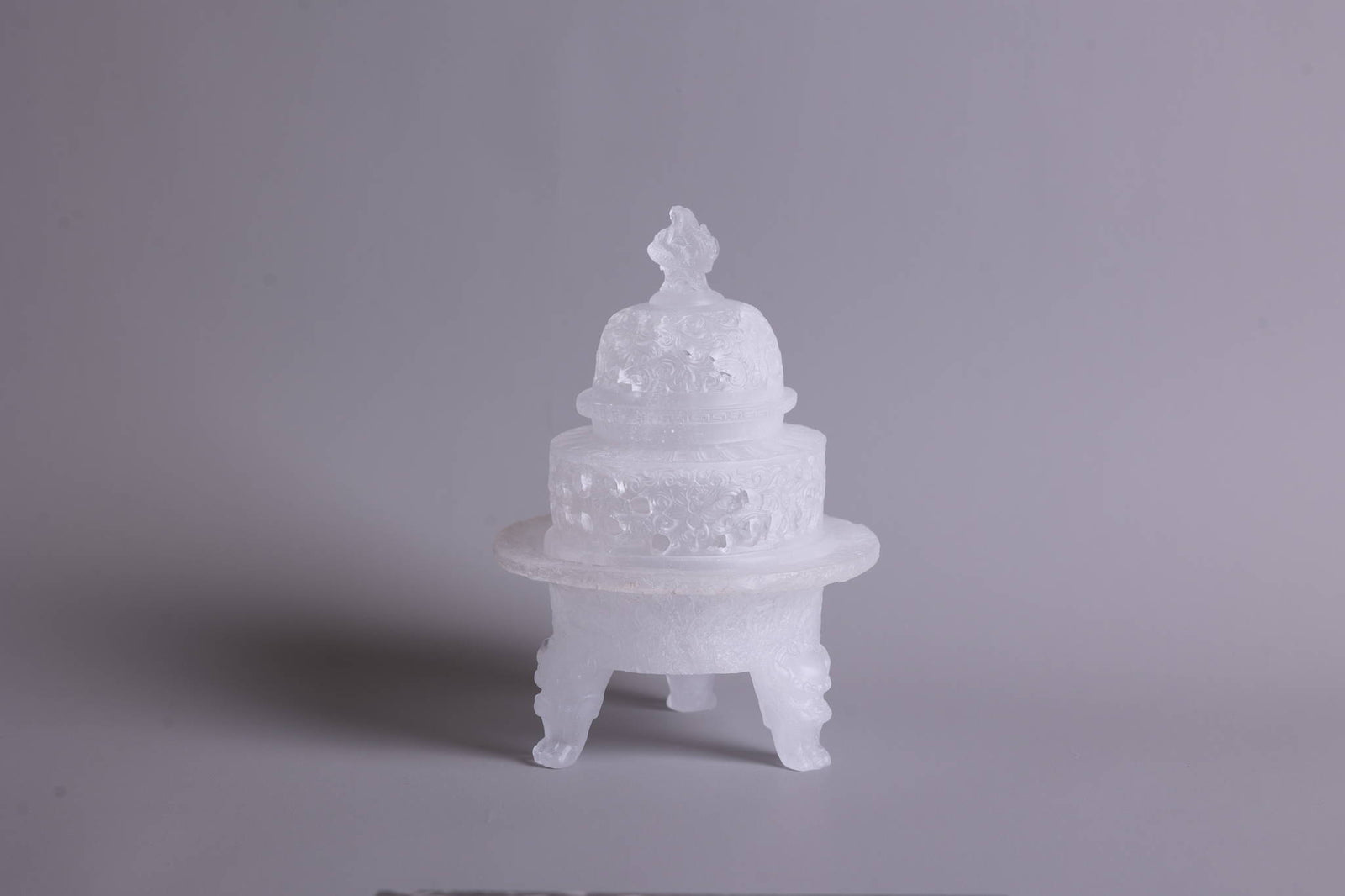Sandalwood is one of the most widely used and recognized incense ingredients in the world. Used by humans for tens of thousands of years, its spread through the world was facilitated primarily from India through the ancient Indian, Arab and Chinese trade routes. Its use is known in ancient civilizations all over the world, widely regarded as a sacred symbol of healing and purity for spiritual ceremonies.
The scientific name for the Sandalwood tree family is Santalum, and is derived from the Sanskrit word Candana or Chandana, meaning “wood for burning incense”. From this, we can see how deeply tied it is with the culture of incense.
It is believed that sandalwood has now been used in China for almost 2000 years. Although it naturally grows in parts of what is now southern China, its use in ancient China was heavily influenced by India and the arrival of Buddhism from there. Some domestic harvesting occurred, but large quantities of sandalwood were imported from India. Sandalwood was known as 白檀香 (bai tan xiang, meaning white tan incense) for an extended period of time in Chinese history. The name “tan” is thought to have derived from the initial letters “Can” of the word Candana. Nowadays people no longer prefix Indian and Australian sandalwood with the word “bai” or white, they are simply referred to as 檀香, tan xiang.
What does sandalwood incense smell like?

Good quality sandalwood has a fresh, woody yet warm, milky scent that is gentle and extremely long lasting. I personally tend to think the scent has a distinct powdery quality to it. While it has a great standalone aroma as well as many individual benefits, it also blends extremely well with a variety of other aromas and acts as a fixative, which means it stabilizes and increases the longevity of the blended scent. This explains its place as a core ingredient in incense and perfumery.
Origins of Sandalwood
Many people are surprised to learn that sandalwood trees are in fact semiparasitic, and must grow on the roots of other trees. There are many species of sandalwood, and besides India and Australia, they also naturally grow in Pakistan, Sri Lanka, Nepal, Indonesia and islands of the South Pacific. These days, wild grown sandalwood is rare, and most sandalwood products on the market come from two specific species, grown in plantations in India and Australia.

As the tree grows, the oil of the wood (when extracted, called essential oil) develops in the roots and the center part of the trunk and branches (called heartwood). It is the essential oils which give the wood the highly desired sandalwood scent. The essential oils require 15-30 years to reach a concentration which makes the wood suitable for harvesting, but the quality of a 50-100 year old tree would be far superior than trees harvested at 15-30 years, as the concentration of essential oils would have increased and the oils matured. As with many wood ingredients for incense sticks, the longer the maturation period, the higher quality the woods, the essential oils and the aroma. The tree is usually harvested by uprooting, so the precious roots with the oils can also be saved for use.
What is the difference between Indian Sandalwood and Australian Sandalwood?
Indian Sandalwood (Mysore Sandalwood)

The Indian Sandalwood (Santalum album) is the most desired type of sandalwood. Historically this was because of its more complex, gentle and longer lasting aroma, although these days we understand these characteristics to be due to its higher concentration of active ingredients α- and β-santalols. The southern state of Karnataka is one of the biggest producers of Indian sandalwood, and the most sought after wood from India is Mysore sandalwood (Mysore is a part of Karnataka).
Today, sandalwood production in India is controlled by the Government due to overexploitation over many years. Despite this, many still believe significant illegal harvesting occurs in India, and the tree is classified as a vulnerable species. Fortunately, Santalum album is now also grown in sustainable plantations in Australia. The aroma of Australian Santalum album mimics traditional Mysore sandalwood, and this has helped to stabilize the market for this highly desired ingredient.
Indian sandalwood has been traditionally used in Chinese incense due to its long history in China, and these days it is commonly referred to as “Laoshan tan” (老山檀) , which literally translates into “old mountain sandalwood”, in reference to traditional, older plantations in Indian.
Australian Sandalwood

Santalum spicatum (Taken by Jean and Fred Hort, used under Creative Commons license and accessed via Flickr )
The Australian Sandalwood (Santalum spicatum) tree is indigenous to South and Western Australia and is also called Waang, Uilarac, Wolgol amongst other names by the local tribes. It also has a great sandalwood scent, although greener and less gentle than high quality Indian sandalwood. The concentration of active ingredients α- and β-santalols is lower in Australian sandalwood.
Due to its more affordable price point, sustainability and stable output, Australian sandalwood is preferred by many incense makers and perfumers today.
Although Aboriginal Australians have used Sandalwood for thousands of years as a source of bush food, medicine and in spiritual ceremonies, Australian sandalwood is still known as “new world” sandalwood for the purposes of Chinese incense making. We really believe this is because Chinese have been more familiar with Indian Sandalwood through the centuries. High quality Australian sandalwood offers many of the benefits of Mysore sandalwood more affordably and sustainably, and makes a dependable incense base.
True Sandalwood
You might sometimes hear the phrase “true sandalwood” being used. True sandalwood refers to the species of trees that scientifically fall under the Santalum classification, most commonly the two described above: Santalum album (Indian sandalwood) and Santalum spicatum (Australian sandalwood). There are some unrelated, scented trees which are also sometimes referred to sandalwood. While the fragrance of these trees may also be valuable and useful, they are sometimes called “false sandalwood” as they do not belong in the Santalum family.
What Is Sandalwood Incense Used For?

Sandalwood has been utilized in religious practices and traditional medicine for many thousands of years. In Hinduism and Buddhism, it is often used for prayer and meditation. In Ayurveda and Traditional Chinese Medicine, it is used to treat a variety of health conditions including those related to digestion and skin. Similarly, Australian Aboriginals have used Sandalwood for over 40,000 years. It is a plant used in smoking ceremonies performed for celebration, healing and cleansing. It is also used for upset stomachs, skin ailments, soothing aching joints, and to repel insects .
In medieval Chinese, incense use was pervasive in the homes of intellectuals, officials, and members of the imperial family. The scent of sandalwood would have been a part of many daily activities - reading, writing, painting, conducting official businesses, and simply reflecting (taking time to sit, reflect and immerse oneself in the surrounding environment was considered a virtue of those times).

Today, sandalwood incense continues to be used for religious ceremonies and traditional medicines, and we are glad that after a very long absence, it is gradually making its way back into everyday life. Sandalwood incense is a soothing scent for finding some calm at the end of the day, to accompany some meditation, yoga, or simply for relaxing before sleep.
Is Sandalwood Incense Calming?
Sandalwood has calming properties which not only helps with relaxing butalso focus – one of the main reasons it was historically used for prayer and meditation. The incense promotes calm for the nervous system, and studies have revealed that sandalwood’s active ingredients α- and β-santalols have neuroleptic properties – ie, they reduce nervous tension and stabilize mood.
Benefits Of Using Sandalwood Incense Sticks
One of the main ways sandalwood can be incorporated into our lives today is through the use of sandalwood incense. Its calming properties can help with a number of issues we experience on a regular basis, including:
- Sandalwood incense reduces anxiety and stress - The calming properties of α- and β-santalols directly reduce anxiety and stress levels.
- Sandalwood incense lowers blood pressure – Anxiety and hypertension are directly linked to high blood pressure, with their reduction, impact on blood pressure is also lowered
- Sandalwood incense relieves insomnia and help with sleep – In lab test with rats, santalol caused a reduction in total waking time and an increase in total non-rapid eye movement sleep time
- Sandalwood relieves some symptoms of depression - The antidepressant effect of sandalwood oil is related to the direct stimulation of the pineal gland after inhalation, resulting in the release of serotonin
- Sandalwood incense has mosquito and other insect repellant properties – Aboriginals have long used sandalwood for insect replant properties, and my own experience is lighting up a sandalwood incense next to an open summer window reduces instances of insects flying in
Moreover, sandalwood essential oils are highly effective for skin conditions, and there is some evidence that sandalwood oil has anticancer effects, with positive effect reported from breast cancer in animal studies. So we can see sandalwood has an abundance of positive benefits for the human body.
Is Sandalwood Incense Effective?
Sandalwood has been tested and documented in many scientific and medical studies. Its effects on anxiety, stress, sleep, skin conditions amongst others are scientifically proven. However, a natural substance generally will not have as much potency or immediacy in treating specific conditions as medicines where the active ingredient has been chemically extracted specifically for the disease.
The way we think about incense use is similar to supplements – great for ongoing, regular use to relieve mild symptoms or discomforts that do not warrant immediate medical attention; also great for improving or maintaining overall wellbeing over time.
Blending Sandalwood Incense Sticks
Sandalwood is the most classic base for blending incense, and it is the base that we use most often (it is the base ingredient we recommend in our article on incense blends and recipes). As mentioned before, it is a very flexible core ingredient, and blends well with many types of ingredients. It is also a very widely used ingredient in perfumery. If you are thinking of blending either your own incense or perfume with sandalwood, here are some common ingredients to experiment with:
Other woods: Aloeswood/Agarwood
Herbs and Spices: Cinnamon, Lemongrass, Citronella, Patchouli
Florals: Lavender, Jasmine, Rose
Resins: Frankincense, Amber, Bezoin, Camphor
How to choose sandalwood incense sticks
The most basic requirement for choosing a high quality incense stick is that it must be all natural. There should be no artificial ingredients or enhancements. We also prefer Chinese or Japanese style incense sticks which are made without a bamboo center, because when the bamboo burns, it interferes with the smell and health benefits of the sandalwood.

We stock a number of incense sticks and cones that contain sandalwood. For something with a focus on the wood itself, you can’t go wrong with Sandalwood Ensemble – an expertly crafted blend from a second generation Chinese incense maker. I like to say it is a blend that smells better than Sandalwood itself – the subtle addition of other ingredients complement the milky warmness of sandalwood to perfection. Sandalwood is also a prominent ingredient of several of our own handmade incense, including Four Masters and Palace Rituals. Of course, if you are just discovering the world of incense, we also welcome you to try our Sandalwood incense sticks from the regular, non-handmade collection. This is also a good quality incense for its price.
A note on burning incense sticks
When used properly, sandalwood incense sticks can provide many benefits for our lives. However we do want to leave a few words of caution:
- Always use an incense burner or incense holder for the incense sticks. This ensures the sticks can burn properly (DIY holders can often obstruct the burning path of incense sticks, preventing them from fully burning); when ashes fall, the incense burner will also help you to catch them, making cleaning up easy
- Never leave burning incense unattended
- Even though the amount of smoke generated by a good quality incense stick is minimal, we'd still suggest using incense sticks in a well ventilated area
-
Where possible, burn incense sticks on a fireproof surface to prevent fire accidents
Do you use sandalwood incense? What do you use it for? What are you favorite blends? Feel free to let us know by leaving a comment below.
--
References:






Leave a comment (all fields required)